KSEEB Class 8 Biology Chapter 3 Reproduction In Animals Notes Learning Objectives
- Types of asexual reproduction Binary fission, budding, spore formation, vegetative propagation, artificial propagation by tissue culture Sexual reproduction in plants
- Review of parts of a typical flower (four whorls and their structure and function)
- Pollination: Self and cross Agents of pollination, Three characteristics of plants pollinated by insects, water and wind (with examples). Characteristics of flowers of each kind
- Fertilization process in brief by flow chart’ Mention of artificial pollination.
- As we have discussed in the previous chapter also, the production of new organisms from the existing organisms of the same species is known as reproduction. In other words, animals also reproduce by giving birth to their young ones. Simple organisms such as yeast and bacteria reproduce by budding or fission.
- Animals also reproduce to continue their generations. Lower animals such as Amoeba and Hydra reproduce by asexual methods involving only one parent. But higher animals such as human beings reproduce by sexual methods involving both parents. In human beings, male and female organs are present in separate individuals.
- Animals reproduce by these two methods—sexual reproduction and asexual reproduction.
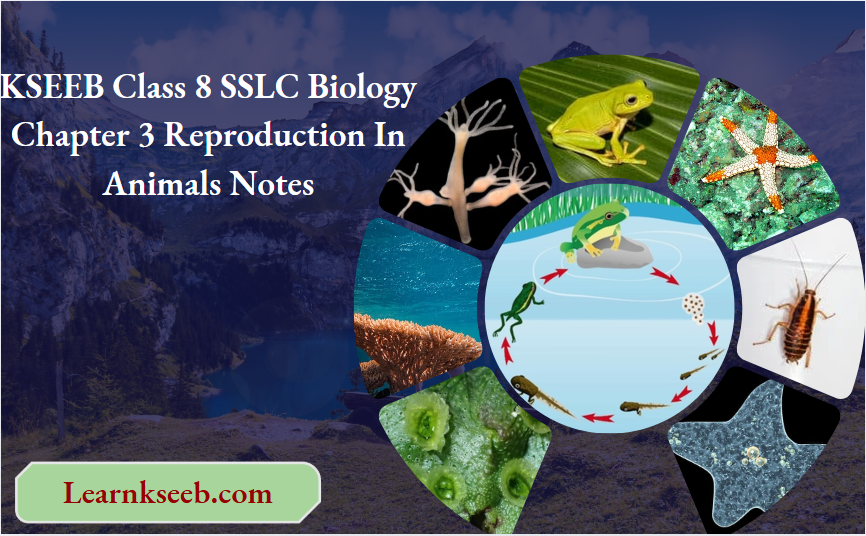
Asexual Reproduction In Animals
- Asexual reproduction is seen in very few animals and especially those of the lower group. Some examples of animals that reproduce asexually arc Hydra, corals, liverworts, Amoeba and starfish. This type of reproduction does not involve the fusion of two sex cells (gametes), i.e. the fusion of egg and sperm. In asexual reproduction, only one parent is involved.
Sexual Reproduction In Animals
- Sexual reproduction involves the fusion of male and female cells to form a fused zygote. The process of fusion is termed as fertilization. As mentioned earlier, most of animals reproduce by the method of sexual reproduction. The process of fertilization may be external (i.e. taking place outside the female body) or internal (i.e. which may be inside the female body). In some animals, the embryo grows outside the mother’s body in a hard-shelled egg. The eggs hatch after some time and the baby comes out of them.
- The fused zygote divides by the method of cell division whereby the cells multiply and grow and they form an embryo. The embryo thus formed remains inside the female body and derives all the nutrition from there till it is mature enough to survive on its own. At the appropriate time and when it reaches certain level of growth, the embryo is expelled from the body of the mother and is capable of surviving on its own. The young one that is born from the mother’s body eventually grows into an adult.
- Animals like cows, horses, dogs, and human beings directly give birth to young ones. Birds and reptiles and some aquatic animals lay eggs and young ones hatch out of them. Insects go through various stages of development before finally becoming adult insects. The offspring produced by these insects are called larvae which is different from the adults. These larvae undergo various stages of development during their lifetime.
System
- In humans, the reproductive system is different for males and females. Let us understand them one by one.
SSLC Class 8 Biology Reproduction In Animals Solutions
Male Reproductive System
- The human male reproductive system consists of the following organs: testes, scrotal sacs, epididymis, sperm ducts, seminal vesicles, and penis. The male reproductive system is primarily made up of a pair of testes (singular: testis) that is located outside the abdominal cavity in a sac known as a scrotum or scrotal sac. The male reproductive cells or male gametes are produced inside the testes. The male gametes are known as sperms.
- The epididymis is a convoluted structure and it serves to store mature sperms. The testes consist of several sperm-producing tubes that join to form sperm ducts. Vas deferens transports sperms from the epididymis to the urethra. Just before the opening of the ducts that arise from each testis, there is a gland known as a seminal vesicle.
- This gland, which is present in each testis, produces a substance that acts like e the medium for the passage of the sperm. This liquid medium mixes with the sperm and forms the semen which is milky in nature. The sperms present in the semen reach the urethra which is present inside the penis. The semen is eventually released through the penis.
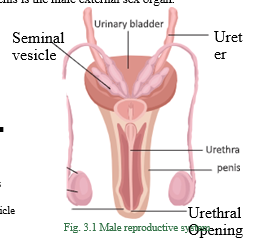
The penis is the male external sex organ.
Female Reproductive System
The female reproductive system primarily consists of a pair of ovaries that bear the eggs or the female gametes known as the ova. The two ovaries are oval in shape and located in the lower part of the abdomen on either side of the uterus. The size of the ovary is about the same as that of an almond.
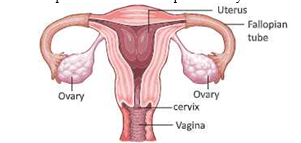
A funnel-shaped tube known as the fallopian tube or the oviduct is present close to the ovary. When the egg is released from the ovary, it passes through the fallopian tube to the uterus. The uterus is a hollow, muscular, pear-shaped structure located in the abdomen of a female. But before it moves to the uterus, it gets fertilized in the fallopian tubes. The lower part of the uterus is narrow and is known as the cervix. The opening of the cervix to the exterior is through a muscular tube called the vagina. The vagina is the part of the female reproductive system that receives the sperm from the male reproductive system.
KSEEB Notes On Reproduction In Animals For Class 8
Menstrual Cycle
The process of ovulation and menstruation in women is called the menstrual cycle (because it occurs again and again after a fixed time period). It is a series of cyclical events and changes that takes place in the inner lining of the uterus of a non-pregnant female. The menstrual cycle is a period of about 28 to 30 days during which an egg cell (or ovum) matures, the mature egg cell is released by the ovary, thickening of the uterus lining takes place, and finally, the uterus lining breaks down causing bleeding in women (if the egg cell has not been fertilized). Initially, the menstrual cycle in girls may be irregular (it may not be for 28 to 30 days). It becomes regular after some lime. The menstrual cycle in women is controlled by hormones. When a mature egg is released from an ovary, it is termed as ovulation. Ovulation occurs on the 14th day of the menstrual cycle.
Fertilization
The sperm made in the testes of a man is introduced by the penis into the woman’s body through the vagina. The sperms enter into the vagina, pass through the uterus and then go into the oviducts. The tail of sperms helps them in moving and reach the oviducts. If at the same time, the ovary of a woman releases an egg (or ovum), then this egg also goes into the oviduct. One of the sperm enters the egg. The fusion of sperm with egg is called fertilization. During fertilization, the nucleus of the sperm fuses with the nucleus of the egg cell to form a single nucleus. This results in the formation of a fertilized egg called the zygote.
Thus, a sperm combines with the egg in the oviduct and fertilizes it to form a zygote. The zygote (or fertilized egg) is the beginning of the formation of a new baby (or a new individual).
Implantation
When the egg is fertilized by the sperm, it starts developing by repeated cell division and forms the zygote. Several cells form during the developing stage and this mass of cells finally reaches the uterus. Here it gets fixed in the wall of the uterus. This fixing of the embryo in the uterus is known as implantation. At this stage, the female is said to be in a state of pregnancy. The growth process of the embryo takes place inside the uterus for the next few weeks where all the vital internal systems as well as the limbs develop.
Sperms enter through the vagina Fertilisation occurs in the oviduct
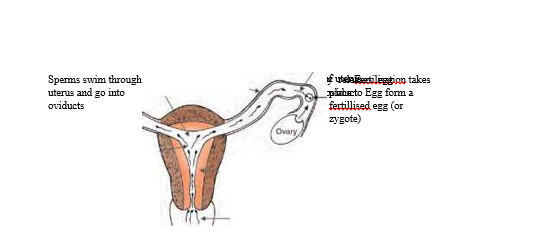
Development of Embryo
The zygote (or fertilized egg) divides repeatedly to make a ball of hundreds of cells. This is called an embryo. The embryo moves down the oviduct into the uterus. The embryo gets embedded in the soft and thick lining of the uterus. This is called implantation. When the embryo settles down in the uterus, the woman is said to have become pregnant (or said to have conceived).
The embryo starts growing in the embryo stage. The unborn baby remains an embryo in the first eight weeks of pregnancy. In a human embryo at 4 to 5 weeks’ development, we cannot identify anybody’s features (hands, legs, head, eyes, ears, etc.) of the developing baby. The embryo continues to grow and develop in the uterus to form a baby. It gradually develops body parts such as hands, legs, head, eyes, and ears, etc. An unborn baby in the uterus at the stage when all the body parts can be identified is called a fetus (The word ‘fetus’ is pronounced as ‘fetus’).
A human embryo becomes a fetus after about eight weeks of pregnancy. From about eight weeks until birth, the unborn baby is called fetus. It takes about 38 weeks (about nine months) from the fertilization of the egg to the formation of a fully developed baby. When the development of the fetus into a baby is complete, the mother gives birth to the baby. The fully formed baby comes out of the mother’s body through the vagina. And we say that a baby is born. This is how humans reproduce by giving birth to babies. All of us were born in this way.
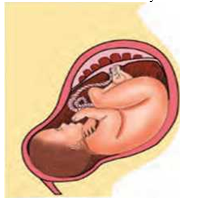
Detailed Notes On Reproduction In Animals KSEEB Class 8
Birth
The development of an embryo in the uterus takes place over a period of about 40 weeks. This is known as the gestation period which could vary by a few weeks for every individual. At the end of the gestation period, the baby comes out of the mother’s body usually with its head first, through the vagina. It requires immense force to push the baby out and this is achieved by the contractions of the muscles of the uterus.
Growth And Development
Growth refers to the increase in the size and number of cells. It is an irreversible process. After the birth of a child, the second stage of growth takes place which is out of the mother’s womb. This stage of growth has the following stages:
Infancy: This is the first stage of growth after the birth of a child and lasts for up to two years. During this time, the babies grow rapidly. They try to speak with single words and learn to sit and stand. They start to recognize the tilings and people around them, especially their mother and father.
Childhood: The period of childhood lasts for up to 12 years of age. Physical changes take place in the body and the child continues to grow intellectually, emotionally, and socially.
Adolescence: Growing up is a natural process. Growth begins from the day a baby is born. A baby grows and becomes a child. A young human being below the age of full physical development is called a child. When a child crosses the age of 10 years or 11 years, there is a sudden spurt in his or her body growth which becomes noticeable. The rapid changes which take place in the body from this age onwards are part of growing up. These changes indicate that the person is no longer a child but he or she is on the way to becoming an adult. A mature human being who is fully grown and developed is called an adult. There is a period of life in human beings when a person is neither a child nor an adult. The transitional period of physical and mental development which occurs between childhood and adulthood is called adolescence. Adolescence can be defined as die time between childhood and adulthood.
Puberty: Although a baby is born with a full set of reproductive organs (both in a male as well as a female), these organs do not function during the first 10 or 12 years of life. Under the influence of hormones produced in the body, the reproductive organs become active at the time known as puberty. A number of physical, mental, and emotional development occur due to hormonal changes. The period of growth in adolescents due to hormonal change is called puberty.
- Puberty tends to start earlier in girls (females) than in boys (males). Generally, girls attain puberty at a lower age of 10 to 13 years while boys reach puberty at a comparatively higher age of 12 to 14 years.
- At puberty, many changes occur in the bodies of boys and girls. In both, boys as well as girls, there is a rapid increase in the rate of growth (height, etc.) during puberty. Puberty is marked by the development of secondary sexual characteristics in boys and girls (such as the growth of facial hair and deeper voice in boys; and the development of breasts and the start of menstruation in girls).

- Voice deepens in boys. It becomes low-pitched. The voice becomes high-pitched.
- Testes enlarge and start to make sperms. Ovaries mature and start to release eggs (or ova). Menstruation (monthly periods) begins.
- The chest and shoulders of boys broaden (become wider). Breasts develop and enlarge. Hips broaden due to the deposition of fats.
- A rapid increase in height occurs. A rapid increase in height occurs.
- Beards and mustaches appear on the face. Chest and No hair on chest, face, or abdomen. Pubic hair starts pubic hair grow. to appear.
Adulthood: An individual is said to be an adult when he or she reaches the age of 18-20 years. The growth process does not stop at this age but slows down considerably. Ail adult is said to be emotionally grounded and mature enough to handle situations. They learn to take independent decisions and attain a sense of responsibility while focusing on their future.
Summary
- Animals reproduce by asexual as well as sexual methods.
- Asexual methods include budding and fission which are seen in unicellular organisms like Amoeba as well as multicellular organisms like Hyara.
- The male and female cells called sperms and eggs are present in the male and female species, respectively.
- The fertilised egg is called a zygote which grows to become an embryo.
- The embryo gets fixed in the uterus and grows further.
- The young one is born when it develops to a certain size and is capable of independent survival.
- A young human baby grows in size and reaches the puberty stage. During this time, several drastic changes take place physically as well as emotionally and the period is known as adolescence.
- A child becomes an adult when he or she reaches the age of 18-20 years.
Part A – Our PASTS – III (History)
- Chapter 1 How, When and Where
- Chapter 2 From Trade to Territory The Company Establishes Power
- Chapter 3 Ruling the Countryside
- Chapter 4 Tribals Dikus and the Vision of a Golden Age
- chapter 5 When People Rebel 1857 And After
- Chapter 6 Colonialism and the City: The Story of an Imperial Capital
- Chapter 7 Weavers, Iron Smelters and Factory Owners
- Chapter 8 Civilising the “Native” Educating the Nation
- Chapter 9 Women, Caste and Reform
- Chapter 10 The Changing World of Visual Arts
- Chapter 11 The Making of the National Movement 1870s -1947
- Chapter 12 India After Independence
Part B – Resources and Development (Geography)
- Chapter 1 Resources
- Chapter 2 Land,Soil, Water, Natural Vegetation and A wildlife Resources
- Chapter 3 Mineral and Power Resources
- Chapter 4 Agriculture
- Chapter 5 Industries
- Chapter 6 Human Resources
Part C: Social and Political Life -III (Civics)
- Chapter 1 The Indian Constitution
- Chapter 2 Understanding Secularism
- Chapter 3 Why Do We Need a Parliament ?
- Chapter 4 Understanding Laws
- Chapter 5 Judiciary
- Chapter 6 Understanding Our Criminal Justice System
- Chapter 7 Understanding Marignalisation
- Chapter 8 Confronting Marginalisation
- Chapter 9 Public Facilities
- Chapter 10 Law and Social Justice
